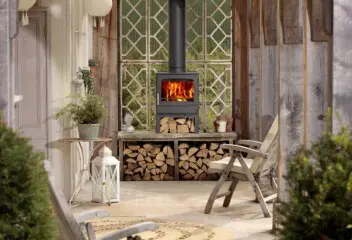Wood burning stoves have risen dramatically in popularity over recent years, providing an additional form of heating for many, and for some, the sole source of heat. Wood burning stoves are cosy, efficient (often three times more so than an open fire) and burning wood can be relatively carbon neutral and sustainable compared to fossil fuels like natural gas, propane, and coal.
And with so many people worried about how they’re going to pay their energy bills with the soaring costs of gas and electricity, more people than ever may be relying on wood burning stoves.
But with new regulations for wood burning stoves that affect the type of log burner you can buy and the fuel you can burn it’s important to get up to speed, whether you already own a wood-burning stove or you’re thinking about investing in one.
Why did new wood burning stove regulations come in?
While emissions and air pollution from domestic burning have reduced significantly since the 1950s, cities are still the worst affected areas. According to the Government’s Clean Air Strategy 2019, wood – and coal – burning stoves accounted for 38 per cent of particulate matter air pollution. It said that not all forms of domestic burning are equally polluting but that it depends on the appliance, such as stove or fireplace, how well it is used and maintained, and what fuels are burnt in it.
However, a Government data published in 2022 significantly cut the estimated proportion of small particle pollution that comes from wood burners to 17% due to updated and more accurate wood fuel usage data for the domestic combustion sector.
Log burner regulations: Are wood burning stoves banned?
No. When the wood burning stove regulations were first announced there was a fear from some that wood burning stoves were going to be banned – but this isn’t the case.
What are the UK wood burning stove regulations?
Under new UK wood burning stove regulations that came into force in 2022, all new wood burning stoves and multi-fuel stoves and fireplaces that are manufactured must meet strict new guidelines known as Ecodesign. Installation must comply with Building Regulations. And there are also rules about the type of fuel you can burn too.
If you already own a wood burning stove that doesn’t meet Ecodesign standards you can still use it. Although if you live in a smoke control area, this may not be the case as there are other criteria you’ll need to meet. Read on for more on smoke control areas.
What are Ecodesign stoves?
The Ecodesign mark means the stove has been independently tested by an approved laboratory and meets requirements on air quality and particulates. Stoves are tested on seasonal efficiency (assessed over a year); levels of nitrogen oxides, carbon monoxide, particulate matter and organic gaseous compounds produced by burning fuel. An Ecodesign stove that’s properly installed and maintained and that uses good quality dry wood is a low carbon heating method using renewable and sustainable fuel.
While ClearSkies is the highest kitemark wood burning stoves can have.
Considering a wood burning stove as part of wider home improvement – but not sure how to fund the work? See our guide How to finance home improvements.
Wood burning stoves and air pollution
However, despite these new regulations, some scientists and experts are concerned about the impact using a wood burner can have on air quality. If you suffer from a health condition that means you’re at greater risk from the effects of air pollution, you may want to think carefully before burning wood in your home.
What are smoke control areas?
So what are smoke control areas? Smoke control areas are specific areas, designated by local councils, where there’s a limit on how much smoke you can release from a chimney and where you can only burn fuel on the list of authorised fuels, unless you use a Defra-exempt stove. These wood burning stoves reduce emissions and minimise soot build up, keeping the flue clearer, allowing gas to escape easily. Under The Clean Air Act, wood cannot be burnt in smoke control areas unless you’re using an exempt appliance.
You could face a penalty of up to £300 in England if your council decides your chimney releases too much smoke. And this rises to up to £1,000 if you burn unauthorised fuel without an exempt appliance.
Find out if you live in a smoke control area by contacting your local council’s environmental services department.
Wood burning stove regulations – what do I need to know about fuel?
Under new log burner regulations that came into force in May 2021, sales of bagged house coal and wet wood in units under two cubic meters became unlawful. And wet wood in bigger volumes must be sold with advice on how to dry it out before it’s burned.
Government rules state: ‘Burning at home, particularly with traditional house coal or wet wood, is a major source of the pollutant PM2.5 – which has been identified by the World Health Organisation as the most serious air pollutant for human health.
‘People with log burners and open fires can still use them, but will be required to buy cleaner alternative fuels – if they are not already – such as dry wood and manufactured solid fuels which produce less smoke.
‘Both of these cleaner options are just as easy to source and more efficient to burn, making them more cost effective.
‘Burning dry wood also produces more heat and less soot than wet wood and can reduce emissions by up to 50%.’
Want to cut your energy use? See our guide for advice on the big energy efficient home improvements to consider, how much they cost and the likely energy savings.
So what type of wood can I burn?
Only certain types of wood are suitable for burning and the wood must be dry. This means it should have a moisture content of less than 20%. It’s very difficult to tell how dry a piece of wood is, so you could either invest in a moisture meter or ensure your wood is ready to burn by purchasing it from a bona fide supplier.
To make it easier for you to find the cleanest fuel to burn at home, DEFRA appointed HETAS and Woodsure to run the Ready to Burn fuel certification scheme. By using fuels that are approved and labelled as Ready to Burn also means it’s easy to comply with Air Quality (Domestic Solid Fuels Standards) (England) Regulations 2020 that outlaw the sale of wet wood and house coal, which are the most polluting fuels. Find suppliers in your area here
Do you need planning permission to install a wood burning stove in the UK?
You don’t usually need planning permission although you may do if you live in a listed building. So it’s important to check with your local council.
If you’re either using a non-HETAS installer to fit your stove, you’ll need to ensure the firm you use is part of a competent person scheme and can self-certify for building control purposes. Otherwise you will need to tell your local Building Control department before starting work. And when the work is completed, they’ll inspect it to make sure all building regulations have been met. And you’ll need to pay for this.
However, by using a HETAS installer to install wood burning stoves, they are qualified to certify the works themselves and can give you a signed certificate of compliance as proof. And this can be used to tell your council about the building work.
And after your stove is fitted, you’ll need to ensure you have a notice plate completed. This is a regulation that records all details of your wood burning stove, hearth, chimney and flue. And it should be next to your hearth, electric meter or water stopcock.
Is it a Legal Requirement to Have a Flue Liner?
While it isn’t a legal requirement to have your chimney lined, if you decide to do so, then there are regulations you must follow to ensure you do it safely, such as making sure you use the recommended flue size for your specific log burner.
And you’ll find most HETAS installers strongly advise having a flue liner fitted for safety and performance reasons including:
- Safety: Flue liners offer protection against carbon monoxide leaks and reduce the risk of chimney fires
- Improved draw: Chimneys typically operate better when using a flue liner.
- Hotter chimney: Cold chimneys can result in more tar and condensation build up.
Make sure your chimney is checked for cracks or damage before installing a new stove. If there are cracks, you’ll need to fit a flue liner. Also, it’s recommended that chimneys built before 1964 are lined because they were made from brick alone.
Log Burner Hearth Regulations
When it comes to wood burning stove regulations, you’ll need to consider your hearth too. Your log burning stove must be placed on a non-combustible material like granite, slate or glass. And it’s important to check the size of your stove before buying a hearth because if your stove doesn’t raise the temperature of the hearth above 100°C:
- The hearth must extend at least 300mm to the front and 150mm to either side
- And the full area of the hearth should be at least 840x840mm
- While it must be at least 12mm thick
However if your stove heats your hearth to over 100°C or it hasn’t been tested, the thickness required increases to 250mm.
Renovating your house and looking for a builder? We’ve teamed up with FMB to help you find trusted builders near you.
Wood burning stove ventilation requirements
Bear in mind that your room may need extra ventilation if you want to have a wood burning stove installed. The log burner ventilation requirements will vary depending on factors like how airtight your home is.
Do I need a carbon monoxide detector with a wood burner?
Yes. You must fit a carbon monoxide alarm in the same room as your wood burner or multi fuel stove. A HETAS installer will make sure you have a working carbon monoxide alarm fitted in the same room as your wood burning stove. Carbon monoxide poisoning can be fatal and you need an alarm to alert you because the harmful fumes are odourless. To cut the risks of carbon monoxide in your home, you should have your stove and chimney inspected annually and fit a flue liner.
5 Top tips for buying a new wood burning stove
If you’re considering investing in a new woodburning stove in your home, these top tips should help:
- Firstly check if you are in a smoke control area. If you are in a smoke control area you will need to look for an appliance that has been verified as Defra Exempt
- Always employ a qualified installer to fit your stove, who will ensure your stove works efficiently, with minimal emissions.
- Ensure your chimney is swept regularly. The more you use your stove the more frequently you will need to sweep.
- Always purchase your wood from a reliable source.
- If using your own wood, make sure you store it in a sheltered store until it is dried to a maximum of 20% moisture content. A moisture meter is a great way to check your wood is dry enough.
Frequently Asked Questions
Are there regulations for installing a wood burner in Scotland?
Yes. Find out about the up to date rules for wood burning stoves in Scotland here
Can existing log burners continue to be serviced or would this trigger the requirement to replace the wood burning stove?
Yes you can continue to use existing wood burning stoves, even if they don’t meet the new Ecodesign standards. However, this is providing there aren’t other criteria you’ll need to meet for example if you live in a smoke free area.
Will I still be able to use my log burner after 2022?
Yes. The new rules on Ecodesign wood burning stoves relate to stoves that are manufactured and sold. So you will be able to use your current log burner after 2022. However, different rules for wood burning stoves apply to what log burners you can use if you live in a smoke control area so if that applies to you, you need to check.
Are wood burning stoves going to be phased out?
No. You can still buy wood burning stoves however they need to meet new criteria. Older types of log burners that are more polluting can no longer be sold.
Do I need building regulations for a wood burning stove?
It depends on who fits it. If you’re either using a non-HETAS installer to fit your stove or doing it yourself, you’ll need to tell your local Building Control department before starting work. And when the work is completed, they’ll inspect it to make sure all building regulations have been met. And you’ll need to pay for this.
But if you use a HETAS installer, they are qualified to certify the works themselves and can give you a signed certificate of compliance as proof. And this can be used to tell your council about the building work.
Are woodburners allowed in converted maisonettes?
What are the rules on installing a wood burner in a mobile home?
Are wood burning stoves going to be banned?
No, there are no plans to ban wood burning stoves. However, the new log burner regulations mean only the cleanest stoves can be sold in 2022 and onward.





 November 24, 2025
November 24, 2025 


